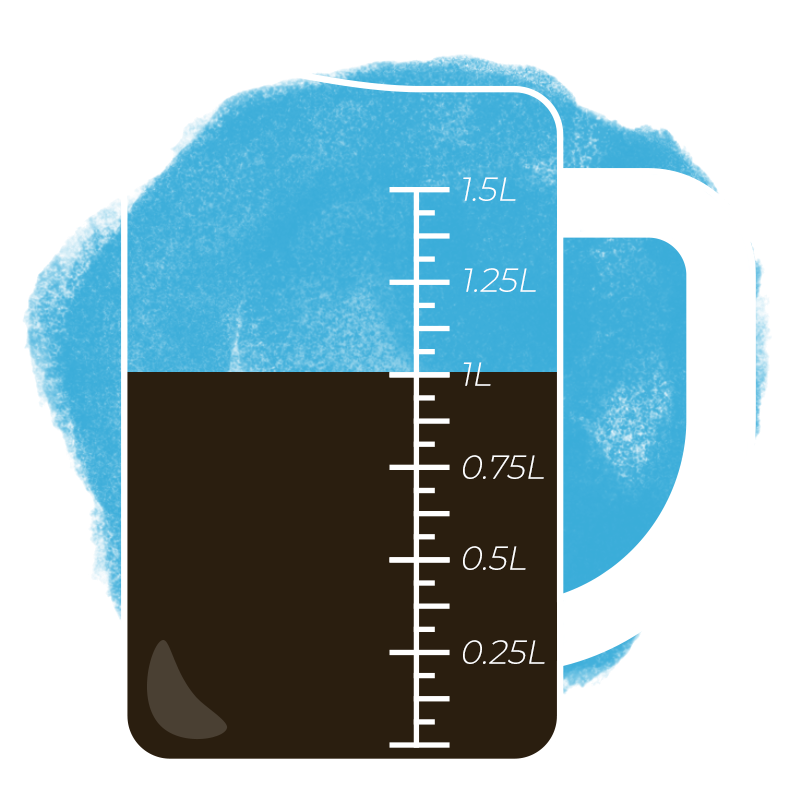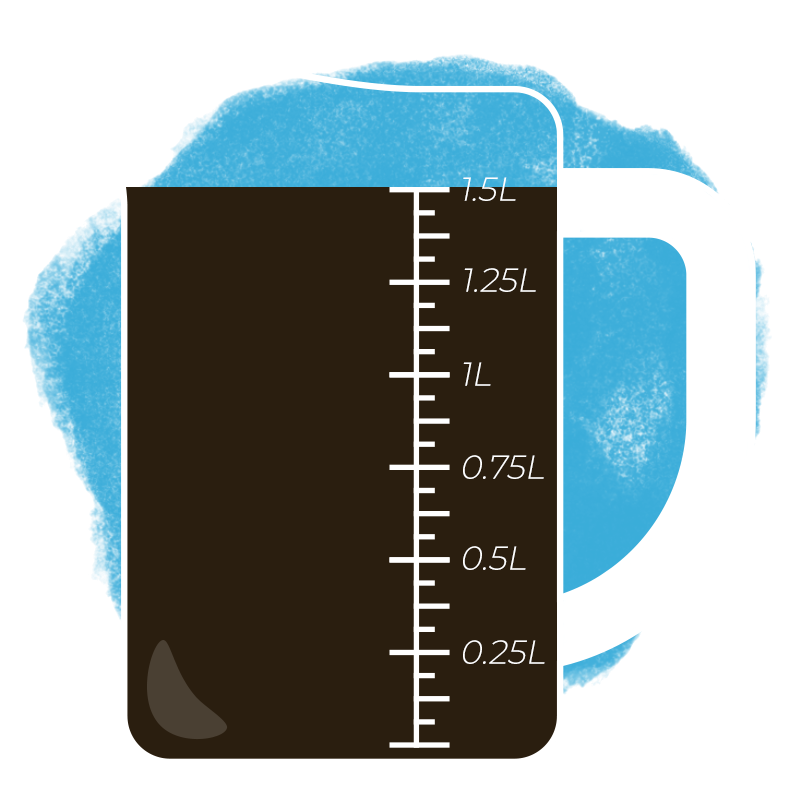Cafetière Coffee: A Guide to French Press Brewing |
 Print this page Print this page
|
Cafetière Coffee:
A Guide to French Press Brewing
Coffee: the fuel of early risers, night owls, and everyone in between. One popular brewing method favoured for its simplicity and elegance is the use of a cafetière, also known as the French press.
Originating in France in the 1850s, the cafetière has grown in popularity worldwide due to its unique ability to create rich, full-bodied coffee.
Let's delve into the art of using this classic device.

What is a Cafetière or French Press?
A cafetière, or French press, is a coffee brewing device characterised by its simplicity and design. It consists of a cylindrical beaker (usually glass, but also available in metal and ceramic), a lid, and a plunger assembly that includes a metal or nylon mesh filter.
French press brewing has a rich history and has gained immense popularity among coffee enthusiasts worldwide. Invented by Attilio Calimani in the late 19th century, the French press, also known as a cafetière or a press pot, remains a popular brewing method to this day.
With its ability to provide full control over brewing variables, the French press offers a unique and enjoyable coffee experience.

How Does a Cafetière Work?
The mechanics of a French press are simple, yet efficient. Coffee grounds are steeped directly in hot water within the beaker, allowing the coffee to infuse. The plunger and filter assembly are then pressed down, separating the brewed liquid from the coffee grounds.
This method allows for full immersion brewing, which extracts complex flavours and oils that other brewing methods may leave behind.

The Science Behind the Cafetière
The extraction of coffee's unique flavours and aromas is a delicate science that involves brewing time, grind size, water temperature, and more.
The cafetière's full immersion method means the coffee grounds are in direct contact with the water throughout the brewing process. This consistent contact facilitates a uniform extraction, producing a well-rounded cup of coffee.

What Do You Need to Make Coffee Using a Cafetière?
To make coffee using a French press, you will need the following equipment and supplies:

French Press
The essential component of the brewing process, a French press typically consists of a glass or stainless steel carafe, a plunger with a mesh filter, and a lid. Choose a size that suits your brewing needs.

Fresh Coffee Beans
Opt for high-quality, freshly roasted coffee beans. It's recommended to use a medium to coarse grind for French press brewing.

Coffee Grinder
Invest in a good quality coffee grinder to ensure a consistent and even grind size. Grinding your coffee beans just before brewing enhances the flavour and aroma.

Kettle
A kettle with a gooseneck spout is ideal for precise water pouring. It allows you to control the water flow, ensuring an even extraction.

Water
Use filtered water for the best-tasting coffee. The water-to-coffee ratio is crucial, so measure the water accurately.

Timer
Having a timer on hand will help you keep track of the brewing time, ensuring consistent results.

Stirring Utensil
A long-handled spoon or paddle for stirring the coffee grounds and water together.

Optional Accessories
While not essential, some additional accessories can enhance your French press brewing experience, such as a coffee scale for precise measurements, a thermometer to monitor water temperature, and a coffee grinder brush for easy cleaning.

The French Press Brewing Process
Brewing coffee with a French press is a straightforward yet rewarding process that allows you to savour the full-bodied flavours and aromas of your coffee. Here is a step-by-step guide to help you master the art of French press brewing:
Heat the water
Start by heating water to the appropriate temperature. Ideally, the water should be heated to around 90-96°C. This temperature range ensures optimal extraction without scorching the coffee grounds.
Measure The Coffee
While the water is heating, measure out the desired amount of coffee beans. For a standard 8-cup French press, a general guideline is to use 28 grams of coffee beans for every 240 millilitres of water. Adjust the amount based on your taste preferences.
Grind the beans
Grind the coffee beans to a coarse consistency, similar to sea salt. The coarse grind allows for proper extraction and prevents the grounds from passing through the mesh filter. If you’re using pre-ground beans, opt for coffee with a coarse grind, intended for a French press.
Add Your Ground Coffee
Add the ground coffee to the French press carafe. (A French press carafe is the container used in a French press brewing system. It holds the coffee grounds and hot water during brewing and has a plunger assembly to separate the brewed coffee from the grounds.)
The initial pour & bloom
Once the water has reached the desired temperature, pour a small amount of hot water (approximately twice the weight of the coffee grounds) over the grounds. This initial pour, known as the bloom, helps release trapped gases and enhances the extraction process. Allow the coffee to bloom for about 30 seconds.
Pour The Remaining Water
After the bloom, slowly pour the remaining hot water into the French press, ensuring all the coffee grounds are fully saturated. Start from the centre and work your way outward in a circular motion.
Position The Plunger
Place the lid of the cafetière, including the plunger with the mesh filter, on top of the carafe. But do not plunge yet. This helps retain heat during the brewing process.
Start the timer
Start the timer and let the coffee steep for 4-5 minutes. Adjust the steeping time based on your desired strength. A longer steeping time can result in a stronger and more robust cup of coffee.
Plunge the coffee
Once the steeping time has elapsed, gently press the plunger down, using even pressure, to separate the brewed coffee from the grounds. Take your time to ensure a smooth and controlled plunge.
Pour & Enjoy
Pour the brewed coffee into your cup or mug, and enjoy the rich aroma and full-bodied flavours of your French press coffee.
Remember, each step of the process, from water temperature to brew time, can be adjusted to suit your personal taste preferences. With practice and experimentation, you'll discover the perfect balance to achieve your desired strength and flavour profile.

Expert Tips For Using A Cafetière
Now that we’ve covered the basics of how to make coffee using a cafetière, let’s dive a little deeper into some of the most important parts of the process so that you can start making French press coffee like an expert.

Choosing the Right Coffee Beans
Choosing the right coffee beans is crucial for achieving a delightful cup of French press coffee. Quality beans are paramount as they greatly influence the flavour, aroma, and overall satisfaction of your brew. When selecting beans for French press brewing, consider various factors.
-
Freshness: Opt for recently roasted beans to ensure optimal flavour and aroma. Look for specialty coffee beans from reputable roasters known for their commitment to quality. At PureGusto we offer a wide range of award winning coffee beans, and use a superior convection coffee roasting process which results in an extremely smooth yet flavourful taste profile.
-
Roast level: Medium to dark roasts are often preferred for French press brewing as they bring out bold flavours that complement the full-bodied nature of the method. However, personal preferences may vary, so feel free to experiment.
-
Coffee Origin: The origin of the coffee beans also plays a significant role. For French press, beans from Central and South America, such as Brazil, Colombia, or Guatemala, are popular choices. These beans often offer a balanced flavour profile with notes of chocolate, nuts, and caramel that harmonise with the French press immersion brewing method.
-
Bean Variety: Arabica beans are generally favoured over Robusta for French press brewing. Arabica beans provide a smoother, more nuanced flavour experience. However, exceptional Robusta beans can contribute to a stronger and more intense cup if that is your preference.

Cafetière Measurements & Ratios
Achieving the right measurements and ratios is crucial when brewing coffee using a French press. The size of your French press determines the appropriate measurements to use, ensuring a balanced and flavorful drink.
Maintaining the correct ratios is essential as it directly impacts the taste of the final brew. For a French press, a coarse, even grind is recommended.
A common starting point is a coffee-to-water ratio of 1:12. For example, if you have 350 grams of water, you'll want to use around 30 grams of coffee. It's worth noting that French press sizes can vary, with common capacities including:

3-cup (0.35L)

4-cup (0.5L)

8-cup (1L)

12-cup (1.5L)

Grinding Coffee For a Cafetiere
Properly grinding coffee beans is a vital step in French press brewing, as it directly impacts the extraction and flavour of your coffee. The ideal grind size for French press brewing is coarse and even. This ensures that the grounds are large enough to be filtered by the mesh screen, allowing for a smooth extraction process and minimising the presence of sediment in your cup.
When grinding coffee for a French press, aim for a texture similar to coarse sea salt. The grounds should be larger and feel gritty to the touch, rather than powdery. This coarser grind promotes a slower extraction process and helps maintain the full-bodied flavour characteristic of French press coffee.
To ensure consistency, it's important to grind your coffee beans just before brewing. This preserves the freshness and flavour of the beans.
Remember to experiment with grind size based on personal preference. If your coffee tastes too weak, try slightly adjusting to a finer grind; if it tastes overly bitter or produces excessive sediment, opt for a coarser grind. Taking notes and keeping track of the grind settings for future reference can help you refine your brewing process over time.

Extraction & Steeping Techniques
Understanding the concept of coffee extraction is crucial when it comes to mastering French press brewing. Extraction refers to the process of dissolving and extracting the flavours, oils, and compounds from the coffee grounds into the water. To control the steeping process and achieve desired flavours, there are a few techniques to explore.
-
Steeping Time: Longer steeping times typically result in a stronger and more intense cup of coffee, while shorter steeping times produce a milder brew. Experimenting with different steeping times allows you to tailor the strength of your coffee to your liking.
-
Coffee-to-water ratio: Increasing or decreasing the amount of coffee relative to the water can impact the strength and flavour intensity of the final brew. Higher coffee-to-water ratios tend to yield stronger cups, while lower ratios produce a more delicate flavour profile.
-
Grind Size: How your coffee is ground plays an important role in extraction. Finer grinds extract more quickly and can result in a bolder flavour, while coarse grinds extract more slowly and offer a smoother taste.
By experimenting with these extraction and steeping techniques, you can fine-tune your French press brewing to achieve the desired flavours and strengths in your cup of coffee. Remember, personal preferences may vary, so don't hesitate to adjust these variables to suit your taste. With practice, you'll gain a deeper understanding of how these techniques impact the flavours and nuances in your French press coffee.

Cafetière Plunging & Serving
The final steps of French press brewing involve plunging the press and serving your freshly brewed coffee. To ensure a smooth and controlled plunge, press the plunger slowly and evenly, applying gentle pressure. This separates the brewed coffee from the grounds while minimising the release of sediment.
When it comes to serving, pour the brewed coffee into preheated cups or mugs to maintain its warmth. Avoid leaving the coffee in the French press for an extended period, as it can continue to extract and result in over-extraction and a bitter taste. If you have brewed more coffee than you plan to consume immediately, transfer the remaining coffee to a separate insulated carafe to help retain heat and freshness.
For presentation, consider garnishing your coffee with a sprinkle of cocoa powder, cinnamon, or a dollop of whipped cream. Serve with a side of cakes or biscuits, or a freshly baked pastry to complement the flavours. Remember to stir the coffee gently before serving to ensure an even distribution of flavours.

French Press Coffee: Troubleshooting Common Issues
Making the perfect cup of coffee with a cafetière is as much an art as it is a science. Here are some of the most common pitfalls people fall into when using a French press, along with tips on how to avoid them:
Using the Wrong Grind Size
Grinding the coffee too fine can lead to a muddy cup and a clogged filter, while too coarse of a grind may result in weak, under-extracted coffee. The ideal grind for a French press is coarse, similar to sea salt.
Over-Extraction
Leaving the coffee in the French press after plunging can lead to over-extraction, making the coffee bitter. To avoid this, pour the coffee into a carafe or your cup immediately after plunging.
Using Incorrect Water Temperature
Water that's too hot can over-extract the coffee, resulting in a bitter taste, while water that's too cool may under-extract it, leading to a weak, underwhelming brew. The ideal water temperature for a French press is between 195 to 205°F (90 to 96°C).
Not Measuring Coffee and Water
Just guesstimating the amounts of coffee and water can lead to inconsistent results. For a more precise brew, use a kitchen scale to measure. A general guideline is a 1:15 ratio of coffee to water.
Inadequate Cleaning
If your French press isn't cleaned thoroughly after each use, old coffee residue can impact the flavour of your next brew. Make sure to disassemble and clean all parts of your cafetière after each use.
Not Preheating the French Press
By pouring hot water into the cafetière before brewing, you can maintain a consistent brewing temperature, leading to better extraction. A cold cafetière can lower the brewing temperature and affect the taste of your coffee.
Skipping the Bloom
The 'bloom' is the process of pouring a small amount of hot water onto your grounds before full immersion. This step helps to release the gases from the coffee, leading to a smoother taste. Not blooming your coffee can result in a less flavorful brew.

Cafetière Cleaning & Maintenance
Proper cleaning and maintenance are essential for keeping your French press in optimal condition. After each use, disassemble the French press by removing the plunger and mesh filter. Rinse the components with warm water to remove any residual coffee grounds. Avoid using harsh detergents or abrasive materials that can damage the carafe or affect the flavour of future brews.
To remove stubborn coffee residue or stains, mix equal parts of water and vinegar, and let the solution soak in the carafe for a few minutes. Scrub gently with a non-abrasive brush or sponge, paying extra attention to the mesh filter. Rinse thoroughly with water afterwards to ensure the removal of any vinegar residue.
Long-term maintenance involves periodic deep cleaning. Disassemble the French press completely and soak all the components in a mixture of warm water and mild dish soap. Scrub each part thoroughly, including the carafe, plunger, and mesh filter. Rinse everything well to remove any soap residue, and allow them to air dry before reassembling.
For optimal performance and durability, handle the French press with care. Avoid sudden temperature changes, such as pouring hot coffee into a cold carafe or placing a hot carafe on a cold surface. Also, be mindful of the delicate nature of the mesh filter and handle it gently during cleaning and reassembly.
When dealing with a stuck French press, it is crucial not to force it down as excessive pressure can cause breakage or even an explosion. Instead, remove the plunger and check if the filter is clogged. Clean the filter thoroughly and consider stirring the coffee or scooping out any excess grounds before attempting to plunge again.

Cafetiere & French Press FAQs
What is the perfect French press ratio?
The perfect French press ratio is typically recommended as 1:12, which translates to one part coffee to twelve parts water. However, this ratio is not set in stone and can be adjusted based on personal preferences.
How much coffee do you put in a French press for 2 cups?
For 2 cups of coffee in a French press, you would typically use approximately 4 tablespoons of coffee grounds. However, this measurement can be adjusted based on your preferred strength and taste.
What kind of coffee is best for French press?
The best kind of coffee for French press is generally medium to dark roasted beans, preferably Arabica, as they bring out bold flavours and work well with the full-bodied nature of French press brewing.
What is special about French press coffee?
French press coffee is special due to its unique brewing method. The immersion brewing technique allows coffee grounds to steep in hot water, extracting rich flavours and essential oils, resulting in a full-bodied cup of coffee.
What is the difference between a French press & a cafetière?
In terms of coffee brewing, there is no difference between a French press and a cafetière. Both terms are used interchangeably to refer to the same brewing device. The term "French press" is more commonly used in North America, while "cafetière" is the term more commonly used in the UK and other parts of the world.
Is cafetière coffee better?
Whether cafetière or French press coffee is better or not than coffee made in other ways is subjective and depends on individual taste preferences. It offers a unique and full-bodied flavour profile due to its immersion brewing method and the presence of oils and sediment in the final cup.
Is it okay to drink french press coffee every day?
Yes, it is safe to drink French press coffee daily as long as you consume it in moderation and consider your overall caffeine intake.
How long do you brew coffee in a cafetière?
The recommended brewing time for cafetière coffee is typically around 4 to 5 minutes. However, you can adjust the brewing time based on your personal preference. Shorter steeping times may result in a milder cup, while longer steeping times can lead to a stronger and more robust flavour.
Is French press a good way to make coffee?
Yes, French press is a popular and effective method for making coffee, known for its ability to produce a rich and full-bodied cup with customizable flavours.
Is a cafetière the healthiest way to make coffee?
The healthiness of coffee preparation methods, including a cafetière, is a topic of debate among experts. While French press coffee retains natural oils and can deliver a robust flavour, it allows more cholesterol-raising compounds to pass through compared to filtered brewing methods. However, moderate coffee consumption has been associated with various health benefits, such as improved cognitive function and reduced risk of certain diseases.
Why is my cafetière coffee bitter?
Bitterness in cafetière coffee can be caused by over-extraction due to excessive brewing time or a fine grind size. Adjusting the brewing time and using a coarser grind can help reduce bitterness.

Make The Best Cafetière Coffee
So there we have it, a complete guide to help you with cafetière or French press brewing with some great tips and tricks to get you started. You should now be able to perfectly brew your coffee in a cafetière every time!
Here at PureGusto, we offer a wide range of high-quality coffee beans and coffee-making equipment which will help you get started on your French press journey. When you purchase our coffee beans, we can either supply them whole, or grind them in-house to your preference. Options include the perfect cafetière grind, as well as grinds for espresso, filter and Turkish coffee.
We have also developed innovative fresh cafetière sachets. Using the same high quality coffee as the rest of our range, these are ideal for providing to customers or guests so that they can easily make delicious French press coffee. They’re also a convenient way to ensure the perfect grind and portion size is available whenever you want to use your cafetière.
If French press coffee is not your thing, we also supply a full range of coffee machines from some of the world’s best manufacturers, including commercial espresso machines and convenient bean to cup machines. So however you prefer to serve your coffee, find everything you need at PureGusto.